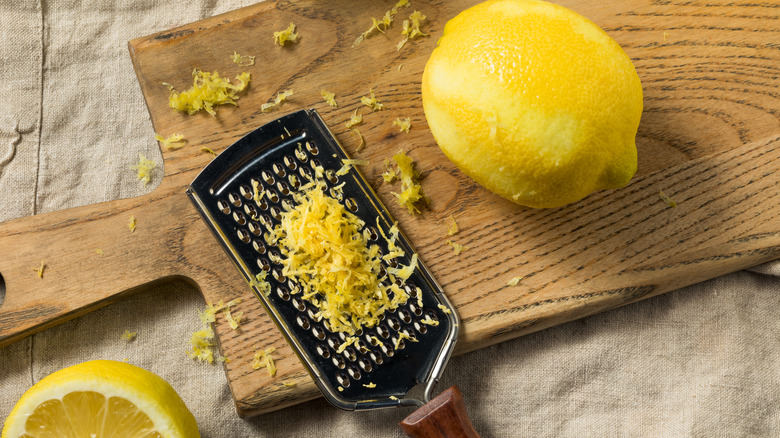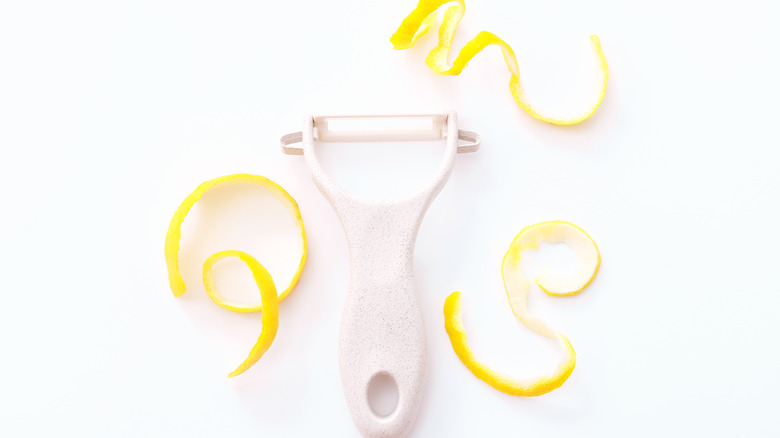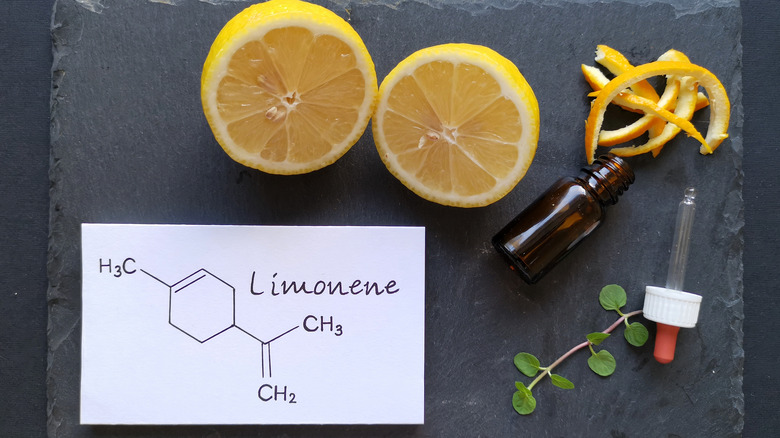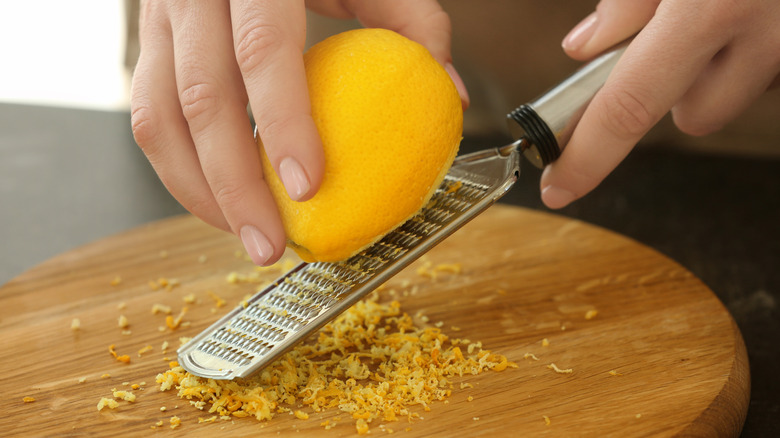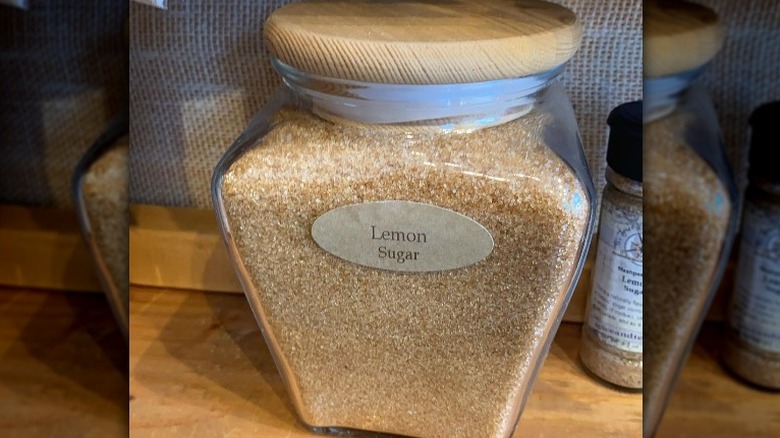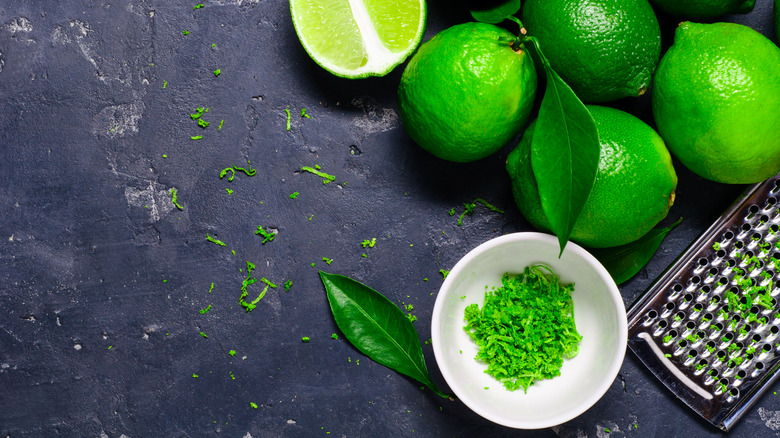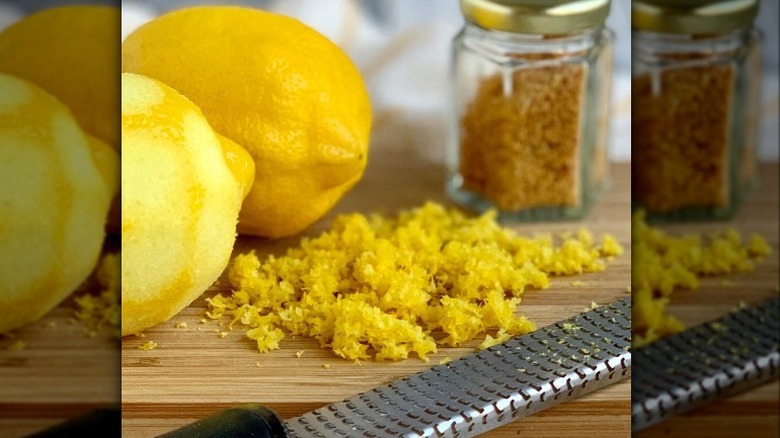The Untold Truth Of Lemon Zest
The introduction of lemons to America dates back to Christopher Columbus' expedition in the late 1400s (via We Are Chefs). Since then, the United States has become a mass grower of the citrus fruit, with California and Arizona leading the way in production. In 2020, 57,300 acres of land in the U.S. were dedicated to the cultivation of citrus fruits such as lemons (via USDA).
Perhaps the best thing about lemons is their highly versatile nature. Lemons can be used to make a sweet and satisfying pitcher of lemonade. Lemons can also be used to liven up seafood dishes, lend a splash of citrus flavor to cocktails and brighten up baked goods. Lemon zest, or the outermost layer of a lemon, is one of the most popular parts of the fruit. Lemon zest is often used as a garnish and as an ingredient in cookies and cakes. It is also added to sauces and marinades.
According to SPICEography, people began incorporating lemon zest in recipes around the 15th century, but the word "zest" didn't become a part of cooking vocabulary until the 17th century. French culture popularized lemon zest as a key ingredient for sweetening and flavoring pastries. Today, lemon zest is a commonly used, highly versatile ingredient that is used in both sweet and savory dishes.
The different between lemon peel and lemon rind
Like most fruits, lemons have a few different parts that make up the whole fruit. However, you might not be referring to the different parts of the lemon correctly. It's important to know the difference between the various lemon parts before tackling a recipe that calls for a specific part of the lemon. The outer portion of the fruit is called the peel.
The peel covers the flesh of the fruit; it covers the citrusy sour part of the lemon. The zest is the outermost part of that peel; it's the brightly-colored yellow part you see on the outside of a lemon (via New England Today). If you were to remove the peel from a lemon, you'd see a whitish, flaky layer underneath: This is the rind, which usually tastes bitter. When zesting a lemon, it's important to avoid the rind to skirt the bitterness and to grate only the outer portion of the peel.
Lemon zest cranks up the flavor of drinks and dishes
Perhaps the number one reason that chefs insist on adding lemon zest to various foods is because of the flavor it brings to the table. While the flesh of a lemon is undoubtedly super tasty, the zest contains truly special elements and hints of flavor. That's because the peel, which is where the zest comes from, is full of natural oils that are rich in smell and taste, giving you that wholesome, invigorating lemon taste that you're likely craving (via Milwaukee Journal Sentinel).
Just a teaspoon of lemon zest is often all you need to garnish pasta, add zing to a cocktail, or insert some bright citrusy flavor to cupcakes. As Jason Hawk, chef-instructor at the Institute of Culinary Education in New York City, tells Insider, lemon zest can bring balance to sweet and salty dishes, making it highly versatile in the kitchen. And, there's even some science behind it: According to Hawk, "The acid in lemon zest helps balance flavor in food, makes food taste more vibrant, and kickstarts saliva production in your mouth."
It has loads of potential health benefits
Lifeway dubs lemon a "superfood" because of its health-boosting properties and the fiber that it contains. When you sprinkle lemon zest on your risotto or your salmon dish, you might be giving it more than just an added dose of flavor. Since the zest of a lemon is derived from its peel, it also includes the many health benefits that lemon peels offer.
According to Healthline, the high number of antioxidants in lemon peels fight free radicals that lead to cell damage. The peel of a lemon can also boost the immune system and reduce the risk of heart disease. Lemon zest may also lead to a healthier mouth.
According to a study published in the Journal of Food Science and Technology, lemon peel contains four different antibacterial substances that are effective in fighting against common oral bacteria that can lead to dental caries and periodontitis. Additionally, lemon peel can also act as a powerful yet gentle cleansing agent for the skin.
It might even help prevent certain cancers
Some research indicates that lemon zest can prevent some cancers: Lemon peels are rich in flavonoids, which are compounds that work with the immune system to avoid inflammation and fight illness (via Healthline).
A 2020 review published in Current Developments in Nutrition studied data on flavonoids and other bioactive compounds that are present in the peels of citrus fruits (like lemons) and their potential cancer prevention benefits. The authors of the study determined that there is enough evidence to suggest that lemon peels have potential application for countering oxidative stress and cellular damage.
D-limonene, another compound found in lemon oil that comes from the peel and zest, may also work towards the prevention of certain cancers, at least in animals. According to Memorial Sloan Kettering Cancer Center, the growth of pancreatic, stomach, colon, skin, and liver tumors has slowed in animal subjects that were given D-limonene treatments, but more research is needed to determine its effects on humans.
Lemon zest can be used for cleaning and skincare
Since lemon zest contains many powerful benefits and properties, its uses extend beyond food and cooking. Lemon zest is also used in home and body products like citrusy body scrubs, exfoliating and energizing face masks, and appliance cleaners. It can also be blended with vinegar to make an all-purpose cleaner that has a pleasant aroma (via Healthline).
Lemon powder has become a popular product at health food stores; brands such as Naturevibe Botanicals sell this versatile product. Lemon powder can be blended with water to create a facial scrub or mask. You don't have to spend money on ready-made products; you can also use lemon zest to create your own lemon powder at home: According to Christina's Cucina, you can use a dehydrator or dry out the lemon zest and turn it into a dry powder. Alternatively, you can also use the oven.
There are multiple ways to zest a lemon
The easiest, most straightforward way to zest a lemon is to use a microplane. This handy kitchen gadget is like a handheld cheese grater with small edges that allows you to grate food items. Microplanes are useful for zesting lemons as they allow you to scrape off small pieces of lemon peel to create zest. This instrument is versatile and convenient because it can be used for many other types of food as well.
However, if you don't have a microplane in your kitchen utensil drawer, don't fret. You can use a citrus zester, which is a tool that is specifically designed to zest citrus fruits, including oranges and limes. You can also use a regular box grater or cheese grater to zest lemons. A vegetable peeler can be utilized to remove the outer layer of the peel. As a last resort, you can use a paring knife to remove the outer peel, as long as you're careful not to get your fingers in the way. After peeling, you can chop up the peel to create zest (via Insider).
Cooks love lemon zest sugar
If you're looking for a new take on traditional, sugary baked goods, try adding lemon zest sugar to cookies, cakes, pies, and other treats. Lemon zest sugar weaves the bright, invigorating flavor and smell of lemon into foods without overpowering them with citrusy flavor.
My Spice Sage is just one brand that sells premade lemon-flavored sugar that is made using dehydrated lemon and lemon oil. Additionally, plenty of cooks have made their own by mixing together lemon zest and sugar. As Sarah Ward explains on her blog, Of the Dirt, dehydrated citrus peels can be transformed into flavored salt or sugar to add a variety of flavors to dishes.
Making lemon zest sugar at home is easy: According to Food in Jars, simply toss your desired amount of lemon zest with plain sugar and combine well. When one Reddit used asked for advice on using lemon zest sugar to make meringue, a few people responded by saying that lemon zest sugar works fine for meringue, though some noted that one has to monitor the amount of zest in the sugar in order to avoid messing up meringue physics.
Lemon zest can be used to make foods healthier
Lemon zest has a powerful taste, which is why just a little bit goes a long way, whether you're incorporating it into recipes prior to cooking or simply sprinkling it atop your dishes as a garnish. Lemon zest has a sweet and impactful flavor that makes a wonderful addition to baked goods, like muffins and donuts. Just a few teaspoons of lemon zest add a wonderful dose of flavor and sweetness.
Due to its strong flavors, some people use lemon zest to enhance the flavor of food while cutting back on some other additives like sugar. For instance, a brownie bites recipe from registered dietician and nutritionist Bethany Thayer substitutes sugar and fat in brownies with pureed mango as well as lemon zest and lemon juice for an enhanced burst of flavor. According to Thayer, adding fruit to baked goods can reduce the amount of sugar needed in the recipe by as much as one-third, whilst also adding a vibrant taste.
Don't like lemon zest? Try these substitutes
If you don't have lemons on hand or if you're just not a fan of lemon flavor, don't worry: There are several substitutes for lemon zest that you can use in your cooking to get similar results.
First, consider using the zest from other types of citrus fruits: The zest from grapefruit, oranges, and limes will all add slightly different types of flavor to your dish and might even appeal more than lemon zest. According to LEAFtv, lemon extract can be a good substitute for zest and you typically need less of it to achieve a similar effect as lemon zest. Plus, lemon extract can be purchased at the store in a pre-packaged readymade bottle.
You can also buy lemon peel powder, which you can blend with other ingredients to emulate the flavor of lemon zest without actually zesting a lemon. Or, you can also make your own powder by peeling several lemons, dehydrating them for up to 12 hours, and grinding them in a coffee grinder. The powder should be stored in an airtight container in the refrigerator (via Brown Thumb Mama).
You can freeze lemon zest to save time in the kitchen
Zesting a lemon can sometimes feel like a chore, especially if you're in a rush to make dinner or you need to zest several lemons at a time. But, you don't need to be stuck with a microplane or citrus zester in one hand and a lemon in the other every time you need some zest. Instead, you can zest a big batch of lemons at one time and freeze the rest: This will allow you to save a few minutes of prep time (via America's Test Kitchen).
Start by zesting as many lemons as you need. You can store lemon zest for up to three months in the freezer, so zest only as much as you think you'll use in that time. Spoon the zest into small servings of up to one teaspoon and put them on a plate. Transfer the plate to the freezer and allow the zest to freeze completely. Then, add the zest to small freezer storage bags or airtight containers and store them in the freezer.
